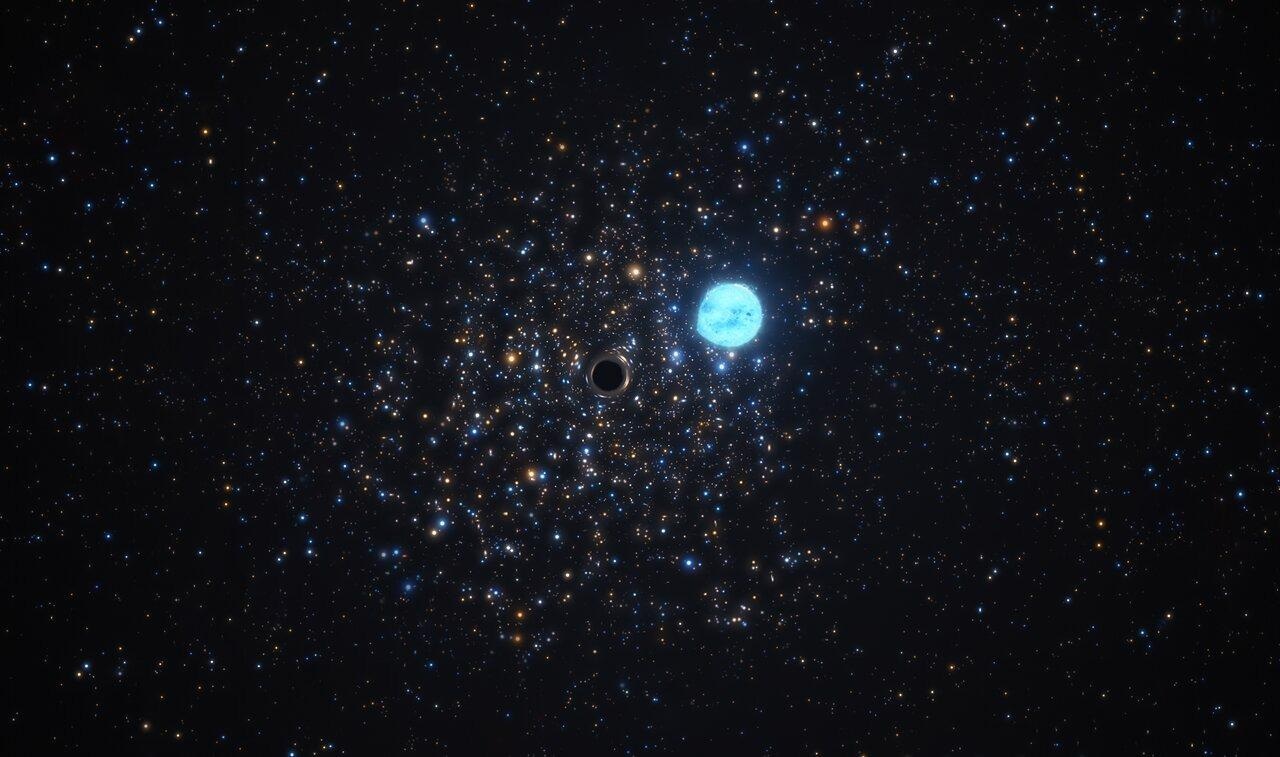Astronomers, with the help of the European Southern Observatory’s Very Large Telescope (ESO’s VLT), have managed to discover a small black hole beyond the Milky Way by observing how it impacts the motion of a star in its surrounding area.
 Artist’s impression of the black hole in NGC 1850 distorting its companion star. (Image Credit: European Southern Observatory).
Artist’s impression of the black hole in NGC 1850 distorting its companion star. (Image Credit: European Southern Observatory).
For the first time, this detection technique has been employed to expose the existence of a black hole beyond the galaxy. The technique could be central to uncovering concealed black holes in the Milky Way and adjacent galaxies, and to help throw light on how these enigmatic objects develop and grow.
The recently discovered black hole was seen lurking in NGC 1850, a group of thousands of stars approximately 160 000 light-years away in the Large Magellanic Cloud, an adjacent galaxy of the Milky Way.
Similar to Sherlock Holmes tracking down a criminal gang from their missteps, we are looking at every single star in this cluster with a magnifying glass in one hand trying to find some evidence for the presence of black holes but without seeing them directly.
Sara Saracino, Study Lead, Astrophysics Research Institute, Liverpool John Moores University
“The result shown here represents just one of the wanted criminals, but when you have found one, you are well on your way to discovering many others, in different clusters,” she added.
The research paper was accepted for publication in Monthly Notices of the Royal Astronomical Society.
This first “criminal” hunted down by the team turned out to be approximately 11 times as big as the Sun. The smoking gun that directed the astronomers on the trail of this black hole was its gravitational effect on the five-solar-mass star orbiting it.
Astronomers have earlier discovered such tiny, “stellar-mass” black holes in other galaxies by detecting the X-ray glow discharged as they swallow matter, or from the gravitational waves produced as black holes crash into another or with neutron stars.
However, the majority of stellar-mass black holes do not reveal their presence through gravitational waves or X-rays.
“The vast majority can only be unveiled dynamically,” explained Stefan Dreizler, a team member located at the University of Göttingen in Germany. “When they form a system with a star, they will affect its motion in a subtle but detectable way, so we can find them with sophisticated instruments.”
This dynamical technique used by Saracino and her team could enable astronomers to locate many more black holes and help reveal their secrets.
Every single detection we make will be important for our future understanding of stellar clusters and the black holes in them.
Mark Gieles, Study Co-Author, University of Barcelona, Spain
The detection in NGC 1850 denotes the first time a black hole has been discovered in a young group of stars (the group is only about 100 million years old, which is just a blink of an eye on astronomical scales).
Using their dynamical technique in analogous star families could uncover even more young black holes and throw new light on how they develop. By equating them with larger, more mature black holes in older groups, astronomers can comprehend how these objects evolve by swallowing stars or combining with other black holes.
Moreover, plotting the demographics of black holes in star groups enhances the understanding of the source of gravitational wave sources.
To conduct their search, the researchers used data gathered over two years with the Multi-Unit Spectroscopic Explorer (MUSE) placed at ESO’s VLT, located in the Chilean Atacama Desert.
MUSE allowed us to observe very crowded areas, like the innermost regions of stellar clusters, analysing the light of every single star in the vicinity. The net result is information about thousands of stars in one shot, at least 10 times more than with any other instrument.
Sebastian Kamann, Study Co-Author, Astrophysics Research Institute, Liverpool John Moores University
Sebastian Kamann is also a long-time MUSE expert.
This enabled the team to spot the strange star whose unusual motion indicated the existence of the black hole. Data from the University of Warsaw’s Optical Gravitational Lensing Experiment and from the NASA/ESA Hubble Space Telescope allowed them to quantify the mass of the black hole and verify their findings.
ESO’s Extremely Large Telescope in Chile, scheduled to commence working later this decade, will enable astronomers to locate even more concealed black holes.
The ELT will definitely revolutionise this field. It will allow us to observe stars considerably fainter in the same field of view, as well as to look for black holes in globular clusters located at much greater distances.
Sara Saracino, Study Lead, Astrophysics Research Institute, Liverpool John Moores University
Journal Reference:
Saracino, S., et al. (2021) A black hole detected in the young massive LMC cluster NGC 1850. Monthly Notices of the Royal Astronomical Society. doi.org/10.1093/mnras/stab3159.